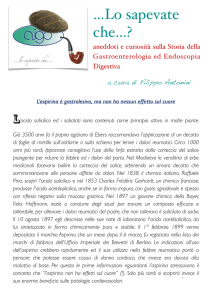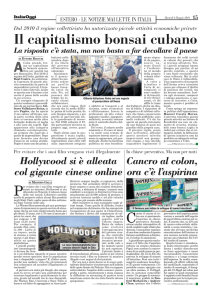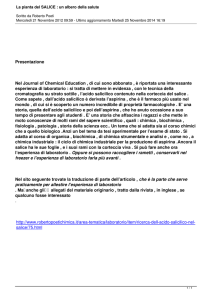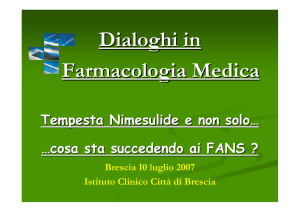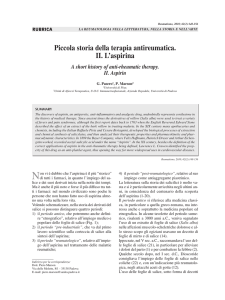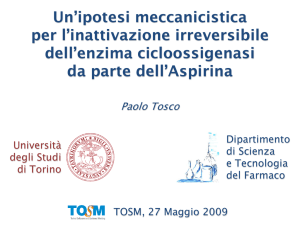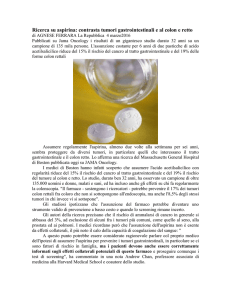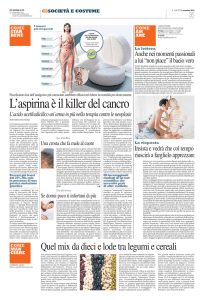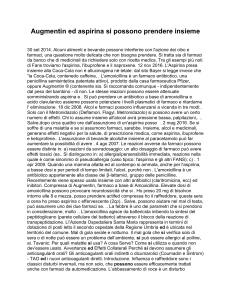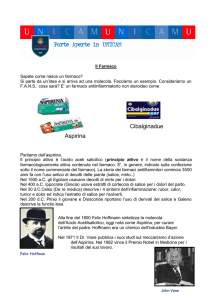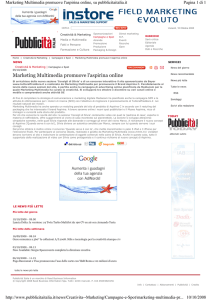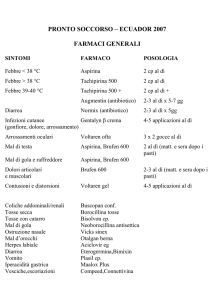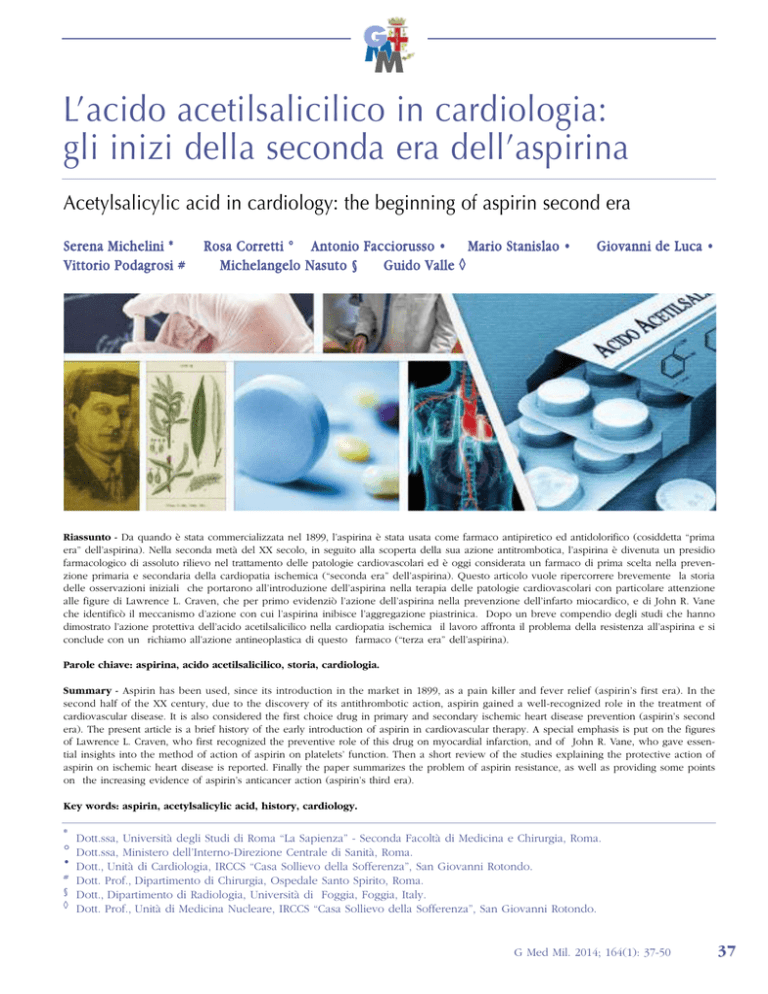
G
M
M
L’acido acetilsalicilico in cardiologia:
gli inizi della seconda era dell’aspirina
Acetylsalicylic acid in cardiology: the beginning of aspirin second era
Serena Michelini *
Vittorio Podagrosi #
Rosa Corretti ° Antonio Facciorusso • Mario Stanislao •
Michelangelo Nasuto §
Guido Valle ◊
Giovanni de Luca •
Riassunto - Da quando è stata commercializzata nel 1899, l’aspirina è stata usata come farmaco antipiretico ed antidolorifico (cosiddetta “prima
era” dell’aspirina). Nella seconda metà del XX secolo, in seguito alla scoperta della sua azione antitrombotica, l’aspirina è divenuta un presidio
farmacologico di assoluto rilievo nel trattamento delle patologie cardiovascolari ed è oggi considerata un farmaco di prima scelta nella prevenzione primaria e secondaria della cardiopatia ischemica (“seconda era” dell’aspirina). Questo articolo vuole ripercorrere brevemente la storia
delle osservazioni iniziali che portarono all’introduzione dell’aspirina nella terapia delle patologie cardiovascolari con particolare attenzione
alle figure di Lawrence L. Craven, che per primo evidenziò l’azione dell’aspirina nella prevenzione dell’infarto miocardico, e di John R. Vane
che identificò il meccanismo d’azione con cui l’aspirina inibisce l’aggregazione piastrinica. Dopo un breve compendio degli studi che hanno
dimostrato l’azione protettiva dell’acido acetilsalicilico nella cardiopatia ischemica il lavoro affronta il problema della resistenza all’aspirina e si
conclude con un richiamo all’azione antineoplastica di questo farmaco (“terza era” dell’aspirina).
Parole chiave: aspirina, acido acetilsalicilico, storia, cardiologia.
Summary - Aspirin has been used, since its introduction in the market in 1899, as a pain killer and fever relief (aspirin’s first era). In the
second half of the XX century, due to the discovery of its antithrombotic action, aspirin gained a well-recognized role in the treatment of
cardiovascular disease. It is also considered the first choice drug in primary and secondary ischemic heart disease prevention (aspirin’s second
era). The present article is a brief history of the early introduction of aspirin in cardiovascular therapy. A special emphasis is put on the figures
of Lawrence L. Craven, who first recognized the preventive role of this drug on myocardial infarction, and of John R. Vane, who gave essential insights into the method of action of aspirin on platelets’ function. Then a short review of the studies explaining the protective action of
aspirin on ischemic heart disease is reported. Finally the paper summarizes the problem of aspirin resistance, as well as providing some points
on the increasing evidence of aspirin’s anticancer action (aspirin’s third era).
Key words: aspirin, acetylsalicylic acid, history, cardiology.
* Dott.ssa, Università degli Studi di Roma “La Sapienza” - Seconda Facoltà di Medicina e Chirurgia, Roma.
°
Dott.ssa, Ministero dell’Interno-Direzione Centrale di Sanità, Roma.
• Dott., Unità di Cardiologia, IRCCS “Casa Sollievo della Sofferenza”, San Giovanni Rotondo.
# Dott. Prof., Dipartimento di Chirurgia, Ospedale Santo Spirito, Roma.
§ Dott., Dipartimento di Radiologia, Università di Foggia, Foggia, Italy.
◊ Dott. Prof., Unità di Medicina Nucleare, IRCCS “Casa Sollievo della Sofferenza”, San Giovanni Rotondo.
G Med Mil. 2014; 164(1): 37-50
37
G
M
M
Introduzione
I salicilati, ininterrottamente usati in
Vecchio (I secolo d.C.) e Galeno (II
Nel 1758 il reverendo Edward Stone
secolo d.C.) trattano del potere antal-
riferì alla Royal Society di aver ottenuto
gico della corteccia di salice.
apprezzabili risultati impiegando la
terapia da oltre 35 secoli, hanno avuto,
con la commercializzazione dell’Aspirina
(ASA, acetylsalicylic acid) da parte
dell’industria farmaceutica Bayer nel
1899, un rinnovato e più largo impiego
in Medicina. All’usuale impiego dell’ASA
come antiflogistico, antipiretico ed antidolorifico (prima era dell’aspirina), si è
aggiunto, nella seconda metà del secolo
scorso, l’impiego come antiaggregante
piastrinico nelle malattie cardiovascolari
(seconda era).
Per comprendere l’importanza del
trattamento con aspirina nella prevenzione secondaria della cardiopatia ischemica basterà qui ricordare che ogni anno
sono colpiti da infarto circa 200.000
italiani, che la metà di essi ha meno di
70 anni, che un quarto dei decessi si
verifica entro le prime due ore dall’insorgenza dei sintomi e generalmente
prima del ricovero e che il 10% degli
infartuati va incontro ad un secondo
infarto entro l’anno. La mortalità nel
primo anno dell’infarto è del 10-13% e
scende al 4-6% negli anni successivi.
Ripercorriamo in questo scritto la
storia entusiasmante dell’introduzione
dell’aspirina nella prevenzione della
cardiopatia ischemica di cui oggi rappresenta un elemento imprescindibile,
mentre si va profilando con sempre
maggiore evidenza un suo ruolo anche
in oncologia (terza era)
La sintesi dell’aspirina
L’uso in medicina della corteccia di
salice (Fig. 1) era già noto agli antichi
Egiziani ed è riportato nel papiro di
Smith, (XVI secolo a.C.). Sia Ippocrate
(V secolo a.C.) che Celso, Plinio il
38
G Med Mil. 2014; 164(1): 37-50
Fig. 1 - Salix alba (salice bianco). Il salice bianco è stato nei secoli scorsi la
principale fonte di salicilati. Peraltro, tali sostanze sono presenti nella
corteccia di molte altre specie appartenenti al genere Salix e di altri vegetali.
Immagine tratta da “Flora von Deutschland in Abildungen nach der Natur” (a cura di
J Sturms), K.G. Lutz editore (organizzazione Eckstein & Stähle), Stoccarda, 1900-1907.
G
M
M
corteccia di salice nella terapia degli
accessi febbrili malarici. A differenza
della corteccia della china, però, quella
del salice era priva di attività sul
plasmodio.
Già nel 1826 due studiosi italiani,
Brugnatelli e Fontana, avevano isolato la
componente farmacologicamente attiva
della corteccia del salice. Due anni dopo,
nel 1828, Johann Buchner, professore di
farmacologia dell’Università di Monaco,
isolò, in forma pura, una piccola quantità di cristalli gialli ed aghiformi della
stessa sostanza cui dette il nome di “salicilina”. Nel 1829 il chimico francese
Henri Leroux migliorò la tecnica estrattiva riuscendo ad ottenere 30 grammi di
salicina da 1.5 Kg di corteccia di salice.
Nel 1833 J.W. Löwig isolò la salicilina
da due ulteriori specie vegetali: le erbe
Gaultheria e Spiarea ulmaria (Fig. 2).
Da quest’ultima (rimedio popolare in
Svezia per la terapia del dolore) già dal
1830 il farmacista svizzero Johann Pagenstecher aveva ottenuto un estratto farmacologicamente attivo. Nel 1838 Raffaele
Piria, un chimico italiano che lavorava
alla Sorbonne, scisse la molecola di salicilina in uno zucchero ed in una componente aromatica (salicilaldeide) e convertì
quest’ultima in un acido cristallizzabile
in forma di aghi incolori cui dette il nome
di acido salicilico.
Nel 1853 il chimico Charles Frédéric
Gerhardt, professore all’Università di
Montpellier, sintetizzò per la prima volta
l’acido acetilsalicilico (Fig. 3) trattando
il salicilato di sodio con cloruro di acetile.
Fig. 2 - Spiraea ulmaria. Specie vegetale ricca in salicilati
da cui deriva etimologicamente la parola “aspirina”.
Immagine tratta da “Flora von Deutschland, Österreich und der Schweiz”
del Prof. Dr. Otto Wilhelm Thomé, Gera, Germania, 1885.
L’acetilazione riduceva sensibilmente la
gastrolesività del salicilato. Nella seconda
merito della messa a punto della tecnica
merito della sintesi. Le rivendicazioni di
metà del XIX secolo vennero migliorate
di acetilazione e quindi della realizza-
Eichengrün sono rimaste pressoché igno-
le procedure di acetilazione.
zione dell’aspirina (1897) gli venne
rate fino al 2000 quando Walter Sneader
La sintesi industriale dell’acido acetil-
contestato dal chimico tedesco di origine
ne ha dimostrato la fondatezza soste-
salicilico è comunemente attribuita a
ebraica Arthur Eichengrün suo superiore
nendo che l’acido acetilsalicilico venne
Felix Hoffmann (1868-1946), laureato in
presso i laboratori della Friedrich Bayer
sintetizzato da Hoffmann grazie alla
chimica a Monaco di Baviera. Tuttavia il
& Co. di Elberfeld che avocò a sé il
guida di Eichengrün (Sneader, 2000).
G Med Mil. 2014; 164(1): 37-50
39
G
M
M
del giovane principe. Fu, indubbiamente,
un’occasione
perduta
per
comprendere il ruolo dell’acido acetilsalicilico nella prevenzione dei meccanismi trombotici.
La trombosi coronarica
Proprio in quegli anni negli Stati
Uniti, James Bryan Herrick (1861-1964),
Fig. 3 - Formule di struttura dell’acido salicilico e dell’acido acetilsalicilico.
altresì noto per i suoi iniziali studi sull’anemia drepanocitica, pubblicava su
JAMA il fondamentale articolo (Herrick,
Il nome commerciale con cui l’acido
acetilsalicilico è universalmente noto è
Un’occasione perduta: Rasputin
e lo zarevic
“Aspirina”. Tale molecola risulta di
40
1912) in cui si dimostrava, che la causa
dell’infarto miocardico è comunemente
rappresentata da un’occlusione trombo-
sapore più gradevole rispetto all’acido
Grigorij Efimovič Rasputin (1869-
tica acuta di un vaso coronarico.
salicilico e dotata di maggiore tollerabi-
1916), discusso monaco russo che
In realtà l’articolo di Herrick, così
lità gastrica. Il termine Aspirina venne
godeva fama di guaritore, fu invitato alla
come la relazione che lo stesso Herrick
brevettato dalla Bayer nel marzo 1899 e
corte dello zar per curare il piccolo
aveva in precedenza presentato al
risulta composto dal prefisso “a” (per
Aleksej (1904-1918) primo figlio maschio
congresso dell’Association of American
acetile), dalla radice “spir”(per Spiraea
ed ultimogenito di Nicola II e della zarina
Physicians, furono accolti con disinte-
ulmaria o olmaria, pianta, come si è
Alessandra. Lo zarevic Aleksej soffriva di
resse. Solo nel 1918 un suo secondo arti-
detto, ricca di salicilati) e dal suffisso
emofilia ed i medici di corte gli sommi-
colo (Herrick, 1918), in cui si dimostrava
“ina”, comune per i farmaci allora impie-
nistravano, del tutto incongruamente,
altresì l’utilità dell’elettrocardiogramma
gati. L’estrazione dei salicilati dalla
aspirina a fini antalgici. Ovviamente tale
nella diagnosi di infarto miocardico,
Spiraea ulmaria risulta di più facile
trattamento, assolutamente controindi-
ottenne il meritato credito (Acierno &
attuazione e consente il risparmio del
cato, non faceva che aggravare la condi-
Worrell, 2000).
salice per altri usi quali, ad esempio, nel
zione emorragica in cui il ragazzo
caso del Salix viminalis (vimini), la
versava. Rasputin, le cui cognizioni di
produzione di cesti e canestri.
farmacologia
paiono
quanto
meno
Lawrence L. Craven
L’aspirina fu il primo farmaco ad
dubbie, ma forte dell’alone di potente
essere sperimentato preventivamente
guaritore che lo circondava, con una
Per quanto nel 1949 Paul C. Gibson
sull’animale (Burke et al. 2006). La sua
fortunata intuizione ordinò di cessare la
avesse pubblicato su Lancet un articolo
popolarità andò grandemente aumen-
terapia con acido acetilsalicilico. Le
sull’efficacia dell’aspirina nei pazienti
tando durante le prime decadi del XX
condizioni di Aleksej migliorarono note-
con angina pectoris (Gibson, 1949),
secolo. Fu il farmaco di riferimento nel
volmente e ciò contribuì ad accrescere
l’uomo a cui si deve la individuazione
trattamento della pandemia influenzale
la fama di santone che aleggiava intorno
dell’azione antitrombotica dell’aspirina
nota come “spagnola” che provocò
al monaco-guaritore.
è il dottor Lawrence L. Craven (Fig. 4).
milioni di morti in Europa negli anni
Malgrado l’elevatissima posizione
Le notizie che riguardano la sua
immediatamente successivi alla fine
sociale del paziente, non risulta a chi
biografia e le sue opere sono quanto
della prima guerra mondiale; non è
scrive che a qualcuno, venne allora
mai scarse e di difficile reperibilità:
escluso che alcuni dei decessi siano
l’idea di indagare la ragione per la quale
quelle disponibili sono riportate da
imputabili a sovradosaggio di acido
la
aveva
Miner e Hoffhines in un interessante arti-
acetilsalicilico.
ridotto la gravità dello stato emorragico
colo apparso nel 2007 sul Texas Heart
G Med Mil. 2014; 164(1): 37-50
sospensione
dell’aspirina
G
M
M
quotidiana di aspirina aveva avuto un
infarto miocardico nei due anni successivi (Craven 1950a).
Nello stesso 1950, in una seconda
lettera pubblicata sul “Journal of Insurance Medicine” egli ribadì il medesimo
concetto e annotava come l’introduzione
dell’uso dell’aspirina a scopo antalgico
nei soggetti da lui sottoposti a adenoidectomia e tonsillectomia fosse risultata
in un importante aumento dei casi di
sanguinamento post-operatorio. Craven
attribuiva inoltre la maggior incidenza
di infarto miocardico nella popolazione
maschile al minore uso di aspirina
rispetto a quanto avveniva nel genere
femminile che la usava più largamente
a scopo antalgico (Craven 1950b).
Craven infine riferiva di aver ricevuto
numerose conferme al suo primo lavoro
da parte di colleghi che, con la somministrazione di aspirina, avevano prevenuto la trombosi coronarica nei loro
pazienti. Nello stesso lavoro Craven, che
aveva ormai esteso lo studio a 1500
pazienti che assumevano quotidianamente una piccola dose di aspirina riferì
di non avervi osservato casi di infarto
miocardico.
Nel 1953, in un terzo lavoro pubblicato sul “Mississipi Valley Medical
Journal” riportò di aver prescritto l’asFig. 4 - Lawrence L. Craven nel giorno della sua laurea.
Ritratto a matita di Cristiano Michelangelo Ferretti (cortesia dell’artista).
sunzione quotidiana di aspirina (325
mg/die) ai soggetti di sesso maschile di
età compresa tra 45 e 65 anni sovrappeso e con stile di vita sedentario e che
Institute Journal al quale abbiamo fatto
come medico di medicina generale
nessuno dei soggetti così trattati aveva
estesamente riferimento. Nato nel 1883
presso il Glendale Memorial Hospital.
sviluppato un infarto miocardico nel
a Truro nell’Iowa (USA), Craven nel 1913
Nel 1950, in una prima lettera pubbli-
ottenne la laurea in Scienze e l’anno
cata sugli “Annals of Western Medicine
In un ultimo articolo che venne pure
corso di diversi anni (Craven, 1953).
successivo conseguì quella in Medicina
and Surgery” Craven avanzò per la prima
pubblicato sul “Mississipi Valley Medical
presso il College of Medicine and
volta l’ipotesi che l’aspirina potesse
Journal” un anno prima della morte
Surgery dell’Università del Minnesota.
prevenire la trombosi coronarica. L’ipo-
Craven -che era giunto a studiare 8000
Dopo la prima guerra mondiale, durante
tesi era suffragata dall’osservazione che
pazienti - riportò che nessuno dei
la quale aveva prestato servizio come
nessuno dei quattrocento pazienti cui nel
soggetti che assumeva quotidianamente
Capitano Medico si trasferì in California
1948 egli aveva prescritto l’assunzione
aspirina era stato colpito da infarto
G Med Mil. 2014; 164(1): 37-50
41
G
M
M
miocardico. Tutti e nove i casi in cui era
regola (talora fin troppo!) la sperimen-
Weiss ed i suoi collaboratori osser-
stata posta clinicamente tale diagnosi
tazione clinica sull’uomo. I lavori di
varono inoltre che le predette azioni
erano risultati, all’esame autoptico, dece-
Craven, privi di un significativo supporto
continuavano a manifestarsi per un
duti per rottura di aneurisma aortico.
statistico, oggi sarebbero addirittura
periodo variabile tra 4 e 7 giorni, anche
Nello stesso lavoro Craven riferì inoltre
rigettati. Probabilmente poi, per il fatto
quando, cioè, l’aspirina non era più
che nessuno dei pazienti trattati con
di aver somministrato un farmaco per
presente in circolo, il che suggeriva che
aspirina era andato incontro a ictus o
indicazioni diverse da quelle per le quali
l’aspirina esercitasse un’azione di tipo
ad attacco ischemico transitorio cere-
era stato messo in commercio (o, come
irreversibile sulle piastrine (Weiss &
brale. Nella discussione dei dati Craven
attualmente si dice per l’impiego off-
Aledort, 1967; Weiss et al. 1968).
focalizzò la sua attenzione su 4 punti:
label) se fosse vissuto oggi, Craven
Per quanto esistesse una crescente
1. L’infarto miocardico è dovuto ad un
avrebbe avuto più di un grattacapo con
evidenza empirica sull’efficacia dell’aspi-
processo trombotico che si sviluppa
le autorità sanitarie e di polizia. Tempi
rina nella prevenzione e nella terapia
rapidamente a livello di una lesione
d’oro quelli di Craven, in cui un singolo
della malattia coronarica e per quanto
aterosclerotica coronarica
medico,
appassionato
gli studi di Weiss avessero identificato
2. L’aspirina produce importanti emor-
ancorchè oscuro, poteva da solo realiz-
nelle piastrine il “bersaglio” dell’azione
ragie nei soggetti sottoposti a tonsil-
zare studi di farmacologia clinica in
antitrombotica dell’aspirina mancava
lectomia e pertanto ha una rilevante
grado di modificare per sempre il corso
ancora, dal punto di vista biochimico la
azione antitrombotica
della Medicina!
spiegazione del meccanismo d’azione
un
clinico
3. I soggetti che assumono aspirina
Occorreva però chiarire, al di là degli
con cui l’acido acetilsalicilico produceva
hanno una probabilità assai ridotta
effetti osservati empiricamente, su quali
i suoi effetti sull’emostasi. L’uomo che
di sviluppare un infarto miocardico
elementi del sistema emostatico/emocoa-
avrebbe risposto a questa domanda,
gulativo si esercitasse l’azione dell’acido
chiarendo i meccanismi molecolari
4. La comunità medica avrebbe dovuto
studiare
ed
acetilsalicilico. Il ricercatore che riuscì ad
dell’azione dell’aspirina, fu uno dei più
approfonditamente gli effetti dell’a-
più
estensivamente
identificare nelle piastrine il bersaglio
grandi farmacologi di tutti i tempi: il
spirina sulla trombosi coronarica
dell’azione dell’aspirina fu il dottor Harvey
professor John Robert Vane, premio
(Craven, 1956).
J. Weiss del Dipartimento di Medicina
Nobel per la medicina nel 1982.
Il lavoro pionieristico di Craven
(Ematologia) del Mount Sinai Hospital and
non ebbe l’immediata ed universale
School of Medicine di New York.
John Robert Vane
risonanza che avrebbe meritato. Lo
stesso Craven, per ironia della sorte,
morì per un infarto miocardico il 18
Harvey J. Weiss
di fuori dei limiti di età (da 45 a 65
Weiss, in due successivi articoli
nel 1944 alla facoltà di chimica dell’Uni-
anni) entro i quali aveva raccoman-
pubblicati nel 1967 e nel 1968, indicò
versità di Birmingham e, ancora studente,
dato l’uso dell’aspirina. E’ quindi
con larga evidenza sperimentale che
accettò l’invito di trasferirsi a Oxford a
probabile che, alla data della morte,
l’azione antitrombotica dell’aspirina si
studiare farmacologia sotto la guida di
non assumesse acido acetilsalicilico
esercitava a livello delle piastrine. In
Harold Burn. Ottenuto il dottorato nel
(Miner e Hoffhines, 2007).
particolare osservò che l’ingestione di
1953 e dopo una breve permanenza all’u-
aspirina, ma non di acido salicilico,
niversità di Yale in California, accettò, dal
gli effetti antitrombotici dell’aspirina
induceva:
1955 una posizione di “senior lecturer”
erano
1. un significativo aumento del tempo
Certo, i tempi in cui Craven indagò
estremamente
favorevoli
in
ambito farmacologico: le rigide normative nazionali ed internazionali sulla
sperimentazione clinica erano ancora di
là da venire né esisteva tutto quell’apparato burocratico-amministrativo che
42
Nato a Tardebigge (Worchestershire)
il 29 marzo 1927, John R. Vane si iscrisse,
agosto 1957 all’età di 74 anni, ben al
G Med Mil. 2014; 164(1): 37-50
di sanguinamento;
2. una ridotta aggregazione piastrinica
da parte del tessuto connettivo;
3. una riduzione del rilascio di ADP da
parte delle piastrine.
presso l’Università di Londra dove mise
a punto una nuova tecnica di dosaggio
biologico (blood bathed superfusion
bioassay) con cui effettuò un notevole
numero di scoperte fondamentali sia
sull’enzima di conversione dell’angioten-
G
M
M
sina
(ACE,
angiotensin
converting
enzyme), sia sulle prostaglandine.
Successivamente altri Autori (Roth &
Majerus, 1975; Lecomte et al 1994, Wu
I primi studi su larga scala
dell’uso dell’aspirina nelle
malattie cardiovascolari
Nel 1969 Vane, insieme a Priscilla
2000) hanno dimostrato che l’aspirina
Piper per la prima volta riportò il ruolo
(ma non l’acido salicilico!) provoca l’ace-
delle prostaglandine e del trombossano
tilazione della serina 530 della COX-1 che
Il primo studio su larga scala volto
A2 (rabbit aorta contracting substance)
è localizzata in prossimità del sito attivo
ad esaminare l’efficacia dell’aspirina
nell’anafilassi (Piper & Vane, 1969). Nel
di COX-1 (tirosina 385). L’interposizione
nella prevenzione della malattia cardio-
1971 Vane scoprì il meccanismo attra-
del residuo acetilico previene il legame
vascolare fu il Physicians’ Health Study
verso il quale l’aspirina esercita la sua
del substrato con il sito attivo e, in defi-
che arruolò 22071 medici maschi di età
azione antinfiammatoria, analgesica ed
nitiva, blocca l’attività cicloossigenasica
compresa tra 40 ed 84 anni. Per un
antipiretica. Egli dimostrò che l’aspirina
piastrinica. Le piastrine, essendo prive di
periodo di 5 anni i soggetti, divisi in due
ed altri farmaci antinfiammatori non
nucleo, non sono in grado di sintetizzare
gruppi, assunsero quotidianamente 325
steroidei inibivano l’attività della cicloos-
proteine e quindi non possono rimpiaz-
mg di aspirina oppure un placebo. I dati
sigenasi (COX), l’enzima che permette la
zare la COX-1 che viene ad essere perma-
preliminari vennero pubblicati nel 1988,
sintesi delle prostaglandine responsabili
nentemente inibita. Di conseguenza le
quelli definitivi l’anno seguente (The
dei quattro sintomi “classici” della flogosi:
piastrine non possono produrre trombos-
Steering Committee of the Physicians’
tumor, dolor, calor et rubor. Tuttavia,
sano con definitiva compromissione della
Health Study Research Group 1988,
inibendo questo enzima-chiave nella
possibilità di formare trombi da parte
1989). I risultati non lasciavano adito a
sintesi delle prostaglandine, i farmaci tipo
della piastrina stessa. L’aspirina inibisce
dubbi: nel braccio che assumeva aspi-
aspirina inibivano anche la formazione
anche COX-2 con un meccanismo
rina l’incidenza di infarto miocardico era
di prostaglandine fisiologicamente impor-
analogo,
tanti quali quelle che proteggono la
(Mitchell et al. 1994) perché il sito di
ma
con
minore
efficacia
ridotta del 44% (p<0.00001) rispetto al
braccio che aveva assunto placebo.
mucosa gastrica dall’acido cloridrico,
legame del substrato di COX-2 è più largo
Stranamente i risultati dello studi
quelle che mantengono la funzione
e flessibile di quello di COX-1 (Kurum-
statunitense trovarono solo parziale
renale e quelle che permettono l’aggre-
bail et al. 1996). Pertanto l’azione anti-
conferma in un contemporaneo studio
gazione piastrinica quando necessaria.
flogistica, antipiretica ed antidolorifica
britannico della durata di 6 anni su 5139
medici britannici (Peto et al, 1988).
L’inibizione di COX da parte dell’aspirina
dell’aspirina richiede dosaggi più alti di
consente di spiegare quindi anche gli
quelli necessari ad ottenere l’effetto
effetti collaterali dell’acido acetilsalicilico.
antiaggregante piastrinico.
Si trattava comunque di studi di
prevenzione primaria, un ambito in cui
Venti anni dopo, con la scoperta di un
Per spiegare l’azione antiflogistica,
l’utilità dell’aspirina è oggi riconosciuta
secondo enzima COX (COX-2), risultò
antidolorifica ed antipiretica dell’acido
solo nei soggetti a rischio ischemico
chiaro che esistono due isoforme dell’en-
salicilico sono stati proposti altri mecca-
elevato (rischio a 10 anni > 20%) calco-
zima COX: la prima, COX-1, regola le
nismi (Xu et al, 1999; Wu 2000).
lato sulla base delle carte del rischio del
funzioni
omeostatiche
“Progetto Cuore “ elaborate dall’Istituto
fisiologiche,
Nel 1982 per le “scoperte sulle prosta-
mentre la seconda, COX-2, media i
glandine e sulle sostanze biologicamente
Superiore di Sanità che tengono conto
processi flogistici (Vane & Botting, 2003).
attive ad esse correlate” John R. Vane
di alcuni fattori di rischio maggiori
Nel 1973 Vane assunse la carica di
ottenne insieme a Sane K. Bergström e
(diabete, ipertensione, ipercolestero-
direttore della ricerca della casa farma-
a Bengt I. Samuelsson il premio Nobel
lemia, fumo, età e genere).
ceutica Wellcome continuando effica-
per la Medicina. Nel 1985 fondò l’Istituto
Si accumulavano invece le prove
cemente le ricerche già intraprese.
di Ricerca “William Harvey” annesso al
dell’utilità clinica dell’aspirina nei soggetti
Negli ultimi mesi del 1975 il gruppo di
St Bartolomew’s Hospital di Londra ove
affetti da cardiopatia ischemica. L’efficacia
Vane pubblicò tre importanti lavori in
focalizzò la sua attenzione sugli inibitori
del trattamento con basse dosi (75-150
cui per la prima volta venivano indicati
selettivi di COX-2 e sulle interazioni tra
mg) quotidiane di aspirina nella preven-
il trombossano A2 (allora chiamato
ossido nitrico ed endotelina. Morì il 19
zione secondaria dei pazienti con coro-
“rabbit aorta contracting substance) e
novembre 2004 in seguito a complicanze
naropatia è stata definitivamente stabilita
le prostacicline.
polmonari post-traumatiche.
nel 2002 con una meta-analisi di 65 studi.
G Med Mil. 2014; 164(1): 37-50
43
G
M
M
Questa analisi ha evidenziato che nei
vascolari, cerebrovascolari o semplice-
pazienti affetti da coronaropatia o da
mente vascolari rispetto ai soggetti sensi-
malattia cerebrovascolare l’aspirina riduce
bili all’aspirina e purtroppo non traggono
il rischio di infarto miocardico non fatale
beneficio dal trattamento aggiuntivo con
del 35% e quello di eventi vascolari gravi
altri inibitori piastrinici (tirofiban, clopi-
del 18%.(Antithrombotic trialists, 2002).
dogrel) (Krasopoulos et al., 2008). La resi-
Nel 1980 la FDA (Food and Drug
stenza all’aspirina rappresenta quindi un
Administration) autorizzò l’uso dell’aspi-
problema importante ed ancora irrisolto
rina dopo ictus ischemico, nel 1985 ne
nella prevenzione secondaria dell’infarto
approvò l’uso dopo infarto miocardico
miocardico e dell’ictus ischemico.
terapia acuta dell’infarto (Fuster &
Prospettive future
Mentre il ruolo dell’aspirina nella
La resistenza all’aspirina
prevenzione secondaria di eventi trombotici vascolari è ampiamente ricono-
L’aspirina rappresenta oggi uno dei
sciuto, la prevenzione primaria con ASA
farmaci più importanti nella prevenzione
è validata solo nei soggetti a rischio
secondaria della malattia coronarica. La
elevato. Gli studi attualmente in corso
risposta individuale al trattamento con
sono essenzialmente volti al perfezio-
aspirina non è però costante. Nei
namento delle indicazioni all’impiego
pazienti trattati con aspirina, infatti, l’ini-
dell’ASA in prevenzione primaria (De
bizione delle piastrine misurata con test
Caterina & Renda, 2012).
di laboratorio è variabile e molti soggetti
La “terza era” dell’aspirina, cioè la
in trattamento con acido acetilsalicilico
prevenzione primaria (Thun et al., 1993)
vanno comunque incontro ad eventi
o secondaria (Lai & Liao, 2013) di
cardiovascolari.
Possibili cause di “resistenza” all’aspirina sono costituite dalla residua
produzione di trombossano da parte di
COX1 e di COX2, l’aumentato turnover
piastrinico, da polimorfismi genetici e
4. Craven L.L.:
Acetylsalycilic acid: possible preventive of
coronary thrombosis.
Ann. West Med. Surg. 1950, 4: 95-99.
5. Craven L.L.:
Coronary thrombosis can be prevented.
J. Insur. Med. 1950, 5: 47-48.
e nel 1996 ne autorizzò l’impiego nella
Sweeny, 2011).
3. Burke A., Smith E., FitzGerald G.:
Analgesici-antipiretici e farmacoterapia
della gotta. In Goodman & Gilman: Le
basi farmacologiche della terapia.
11esima edizione, McGrow-Hill, Milano,
2006.
neoplasie, come quelle del tratto alimentare e, in particolare, del colon sembra
6. Craven L.L.:
Experiences with aspirin (acetylsalicylic
acid) in the nonspecific prophylaxis of
coronary thrombosis.
Miss. Valley Med. J. 1953, 75: 38-44.
7. Craven L.L.:
Prevention of coronary and cerebral
thrombosis.
Miss. Valley Med. J. 1956, 78: 213-215.
8. De Caterina R. & Renda G.:
Clinical use of aspirin in ischemic heart
disease: past, present and future.
Curr. Pharm. Des. 2012, 18(33): 5215-5123.
9. Fuster V. & Sweeny J.M.:
Aspirin a historical and contemporary
therapeutic overview.
Circulation 2011, 123: 768-778
ormai chiaramente dischiudersi rinnovando, ancora una volta, le indicazioni
all’impiego di questo vecchio ma prodigioso farmaco.
10. Gibson P.C.:
Aspirin in the treatment of vascular
diseases.
Lancet. 1949, 2(6591):1172-1174.
dalla scarsa aderenza del paziente al trattamento (Kasmeridis et al., 2013). Inoltre
la biodisponibilità dell’aspirina può
Bibliografia
essere ridotta dalla contemporanea
assunzione di inibitori della pompa
protonica per inattivazione dell’aspirina
stessa da parte delle esterasi della
1. Acierno L.J. & Worrell L.T.:
James Brian Herrick.
Clin. Cardiol. 2000, 23: 230-232.
mucosa intestinale (Patrono et al., 2005).
Lo studio di Krasopoulos e coll. indica
che una percentuale compresa tra il 16
ed il 30% dei soggetti è resistente all’aspirina. Questi pazienti hanno un rischio
quadruplicato di sviluppare eventi cardio-
44
G Med Mil. 2014; 164(1): 37-50
2. Antithrombotic Trialists’
Collaboration:
Collaborative metaanalysis of randomised
trials of antiplatelet therapy for prevention
of death, myocardial infarction, and
stroke in high risk patients.
BMJ 2002, 324: 71-86.
11. Herrick J.B.:
Certain clinical features of sudden
obstruction of the coronary arteries.
Trans. Assoc. Am. Phys. 1912, 27: 1W105.
12. Herrick JB:
Concerning thrombosis of the coronary
arteries.
Trans. Assoc. Am. Phys. 1918, 33:408-415.
13. Kasmeridis C., Apostolakis S., Lip
G.Y.H.:
Aspirin and aspirin resistance in
coronary artery disease.
Curr. Opin. Pharmacol. 2013, 13: 242-250.
G
M
M
14. Krasopoulos G., Brister S.J., Beattie
W.S., Buchanan M.R.:
Aspirin “resistance” and risk of
cardiovascular morbidity: systematic
review and meta-analysis.
BMJ 2008, 336: 195-198.
15. Kurumbail R.G., Stevens A.M., Gierse
J.K., McDonald J.J., Stegeman R.A.,
Pak J.Y., Gildehaus D., Miyashiro J.M.,
Penning T.D., Seibert K., Isakson P.C.,
Stallings W.C.:
Structural basis for selective inhibition of
cyclooxygenase-2 by anti-inflammatory
agents.
Nature1996, 384:644–648.
16. Lai S.W. & Liao K.F.:
Aspirin use after diagnosis improves
survival in older adults with colon cancer.
J. Am. Geriatr. Soc. 2013, 61(5): 843-844.
17. Lecomte M., Laneuville O., Ji C.,
DeWitt D.L., Smith W.L.:
Acetylation of human endoperoxide
synthase-2 (cyclooxygenase-2) by aspirin.
J Biol Chem. 1994; 269 (18): 13207–13215.
18. Miner J. & Hoffhines A.:
The discovery of aspirin’s antithrombotic
effects.
Tex. Heart Inst. J. 2007, 34: 179-186.
19. Mitchell J.A., Akarasereenont P.,
Thiemermann C., Flower R.J., Vane J.R.:
Selectivity of nonsteroidal antiinflammatory drugs as inhibitors of
constitutive and inducible
cyclooxygenase.
Proc Natl Acad Sci U S A. 1994, 90 (24):
11693–11697.
20. Patrono C., García Rodríguez L.A.,
Landolfi R., Baigent C.:
Low-dose aspirin for the prevention of
atherothrombosis.
N. Engl. J. Med. 2005, 353: 2373-2383.
21. Peto R., Gray R., Collins R., Wheatley
K., Hennekens C., Jamrozik K.
Warlow C. Hafner B. Thompson E.,
Norton S., Gilliland J., Doll R.:
Randomised trial of prophylactic daily
aspirin in British male doctors.
Br. Med. J (Clin. Res. Ed.) 1988, 296:
313-316.
22. Piper P.J. & Vane J.R.:
Release of additional factors in
anaphylaxis and its antagonism by antiinflammatory drugs.
Nature 1969, 223. 29-35.
23. Roth G.J. & Majerus P.W.:
The mechanism of the effect of aspirin on
human platelets, I: acetylation of a
particulate fraction protein.
J. Clin. Invest. 1975, 56: 624–632.
24. Sneader W.:
The discovery of aspirin: a reappraisal.
BMJ (Clin. Res. ed.) 321 (7276): 15911594.
28. Vane J.R. & Botting R.M.:
The mechanism of action of aspirin.
Thromb.
Res. 2003, 110 (5-6): 255-258.
29. Weiss H.J. & Aledort L.M.:
Impaired platelet-connective –tissue
reaction in man after aspirin injection.
Lancet 1967, 2: 495-497.
30. Weiss H.J., Aledort L.M., Kochwa S.:
The effect of salicylates on the hemostatic
properties of platelets in man.
J. Clin. Invest. 1968, 47: 2169-2180.
31. Wu K.K.:
Aspirin and salicylate an old remedy
with a new twist.
Circulation 2000, 102: 2022-2023.
32. Xu X.M., Sansores-Garcia L., Chen
X.M., Matijevic-Aleksic N., Du M., Wu
K.K.:
Suppression of inducible cyclooxygenase2 gene transcription by aspirin and
salicylate.
Proc. Natl. Acad. Sci. U S A. 1999, 96 (9):
5292–5297.
25. The Steering Committee of the
Physicians’ Health Study Research
Group.
Preliminary report: findings from the
aspirin component of the ongoing
Physicians’ Health Study.
N. Engl. J. Med. 1988; 318: 262-264.
26. The Steering Committee of the
Physicians’ Health Study Research
Group.
Final report on the aspirin component of
the ongoing Physicians’ Health Study.
N. Engl. J. Med. 1989; 321: 129-135.
Ringraziamenti
Gli Autori desiderano esprimere la
loro riconoscenza a Cristiano Michelangelo Ferretti, di Roma, per la realizzazione del ritratto di L.L. Craven e a
27. Thun M.J., Namboodiri M.M., Calle
E.E., Flanders W.D., Heath C.W. Jr:
Aspirin and risk of fatal cancer.
Cancer Res. 1993, 53(6): 1322-1327.
Gianmarco
Mischitelli,
di
San
Giovanni Rotondo, per il supporto
informatico fornito.
G Med Mil. 2014; 164(1): 37-50
45
G
M
M
Acetylsalicylic acid in cardiology:
the beginning of aspirin second era
Serena Michelini *
Vittorio Podagrosi #
Rosa Corretti ° Antonio Facciorusso • Mario Stanislao •
Michelangelo Nasuto §
Guido Valle ◊
Introduction
The salicylates which have been
Mortality rates on the first heart attack
In 1758 Reverend Edward Stone
in a year are 10-13%, then 4-6% in the
reported to the Royal Society about his
following years.
satisfying results with the employment
used continuously in therapies for more
In the present article we go back over
of willow bark in the treatment of
than 35 centuries - with the Aspirin
the history of the introduction of aspirin
malaria fever attacks. Compared with the
(ASA, acetylsalicylic acid) commerciali-
and its key role in ischemic cardiopathy
china bark, the willow one lacked the
zation -1899, Bayer Pharmaceutics –
prevention as well as the newly emer-
activity on plasmodium.
have had a renewed and wider employ-
ging role in oncology (third era).
In 1826 two Italian researchers –
ment in medicine.
Brugnatelli and Fontana- had isolated
After the usual ASA employment as
an
antiphlogistic,
antipyretic
and
the pharmacologically active elements
The aspirin synthesis
of the willow bark. Two years later, in
painkiller (as Aspirin was previously
1828, Johann Buchner, Professor in Phar-
used) the antiplatelet drug use for
The employment of the willow bark
macology at the University of Munich,
cardiovascular diseases (second era) was
in medicine (Fig. 1 - Salix alba (white
isolated – in pure form - a small amount
added, during the second half of last
willow). The white willow was in the past
of yellow needle shaped crystals of the
century.
centuries the main source of salicylates.
same substance which was called
In order to understand the impor-
are
“salicin”. In 1829 the French chemist
tance of the aspirin treatment in the
present in the bark of many other species
Henri Leroux improved the extraction
secondary prevention of the ischemic
of the Salix as well as of other plants.
technique and obtained 30 gr. of salicin
cardiopathy, it would be useful to note
Picture from “Flora von Deutschland in
from 1.5 kg of willow bark.
that every year there are 200.000 Italians
Abildungen nach der Natur” (a cura di
In 1833 J.W. Lőwig isolated the
affected by myocardial infarction. Half
J Sturms), K.G. Lutz editor (organiza-
salicin from two further vegetal species:
of this number is in their ‘70s and one
tion Eckstein & Stähle), Stuttgard, 1900-
herbs Gaultheria and Spiarea ulmaria
fourth of the deaths occur two hours
1907) was already known by ancient
(Fig. 2 - Spiraea ulmaria. Vegetal species
before the symptoms insurgence and
Egyptians and it’s recorded in the Smith’s
rich in salicylics from which, it comes
generally before the hospitalization.
papyrus (XVI B.C.). Hippocrates (V
out ethymologically, the term “aspirn”.
Furthermore 10% of the people who
B.C.), Celsus and Pliny the Elder (I B.C.)
Picture by the “Flora von Deutschland,
suffered the heart attack are subjected
and Galenus (II B.C.) talk about willow
Österreich und der Schweiz” del Prof.
to a second heart attack within a year.
bark anthalgyc properties.
Dr.
Furthermore,
such
substances
Otto
* MD, University of Rome “La Sapienza” – Second Faculty of Medicine and Surgery, Rome.
°
MD, Ministry of Interiors-Healthcare Head Office, Rome.
• MD, Cardiology Unity, IRCCS “Casa Sollievo della Sofferenza”, San Giovanni Rotondo.
# Prof. MD, Surgery Department, Hospital of Santo Spirito, Rome.
§ MD, Radiology Department, University of Foggia, Foggia, Italy.
◊ Prof. MD, Nuclear Medicine Unity, IRCCS “Casa Sollievo della Sofferenza”, San Giovanni Rotondo.
46
Giovanni de Luca •
G Med Mil. 2014; 164(1): 37-50
Wilhelm
Thomé,
Gera,
G
M
M
Germany, 1885). The last one – the
Such a molecule tastes much better
treatment to be stopped. Aleksej’s
Spiarea ulmaria – was commonly used
than the acetylsalecythic acid and is also
condition improved immediately which
in Sweden in pain killer therapy. In 1830
gastrically more tolerable. The term
contributed to increase the monk’s fame
the Swiss pharmacist Johann Pagenste-
“Aspirin” was patented by Bayern in
as a healer and holy-man. Notwithstan-
cher has obtained a pharmacologically
1899. It is made of the prefix “a” (acetyl),
ding the high social position of the
active extract. In 1838 Raffaele Piria, an
the core “spir” (Spiraea ulmaria or
patient, nobody tried to understand
Italian chemist working at the Sorbonne,
olmaria, a plant rich in salicylates) and
why the suspension of the aspirin
split the salicin molecule into a sugar
by the suffix “in”, common for the drugs
reduced the gravity of Tsarevitch’s
and an aromatic element (salicylal-
used at that time. The extract of salicy-
health situation. It represents indeed a
dehyde) and converted it in a crystalli-
lates from the Spiraea ulmaria is easier
lost occasion to understand the role of
sable acid in non coloured needle form
than from the willow. It also allows the
acetylsalecythic acid in the prevention
which was named salicylic acid.
willow to be saved for other employ-
of thrombosis mechanisms.
In 1853 the chemist Charles Frédéric
Gerhardt, Professor at the University of
ments such as basket – Salix viminalis
- production.
The coronaric thrombosis
Montpellier, synthesized for the first time
Aspirin was the first drug tested on
the acetylsalecythic acid (Fig. 3 - Struc-
animals (Burke et al. 2006). Its popula-
ture formulas of the Salicylic Acid and
rity increased during the first decades
In the same years in the United
Acetylsalicylic Acid) treating the sodium
of XX century. It was the main drug
States James Bryan Herrick (1861-
salicylate with acetylene chloride. The
employed in the treatment of flu pande-
1964) – also known because of his
acetylation
the
mics called “spagnola” which caused
studies on the sickle-cell anaemia
millions of deaths in Europe in the years
(SCA) – was publishing on the JAMA
During the second half of XIX
following the end of the First World War.
the fundamental article (Herrick, 1912)
century acetylation procedures were
Some deaths are possibly imputable at
which demonstrated how the cause of
improved.
the overdose of the acetylsalicylic acid.
the myocardial infarction is commonly
sensitively
reduced
salicylate gastrolesivity.
an acute thrombotic occlusion of a
The industrial synthesis of the
coronary vessel.
acetylsalecythic acid is commonly attributed to Felix Hoffman (1868-1946)
who graduated in chemistry at the
A lost occasion: rasputin and
the tsarevitch
The Herrick article as well as his
report briefed at the Association of
American Physicians congress, hasn’t
University of Munich. Nevertheless his
success in the realization of the acety-
Grigorij Efimovič Rasputin (1869-
met huge interest. In only 1918, a further
lation technique – thus of the aspirin
1916), the controversial Russian monk
article (Herrick, 1918) demonstrated
realization (1897) – was contested by
renown as a healer, had been invited
how the electrocardiogram was useful
the German Jewish chemist, Arthur
to the tsar court to cure the little Aleksej
in the identification and diagnosis of
Eichengrűn, his supervisor at the Frie-
(1904-1918) the first male child and the
myocardial infarction, and had the right
drich Bayer & Co Laboratories of Elber-
last-born of Nicola II and the Tsarina
success (Acierno &Worrell, 2000).
feld who took upon himself the credit
Aleksandra. The tsarevich had a case
of the synthesis. Eichengrűn claims
of hemophilia and court doctors admi-
have been ignored since 2000 when
nistered to him – incongruously- aspirin
Walter Sneader demonstrated their legi-
for analgesic purposes. Such a treat-
timacy by stating that the acetylsa-
ment
–
obviously
unsuitable
–
Lawrence L. Craven
In 1949 Paul C. Gibson published an
lecythic acid has been synthesized by
worsened the Tsarevitch haemorrhagic
article in the Lancet on the efficiency of
Hoffman due to the Eichengrűn guide
conditions. Rasputin – whose pharma-
Aspirin in angina pectoris patients
(Sneader, 2000).
cological notions were quite uncertain
nevertheless the person who understood
but whose fame as a powerful healer
the Aspirin antithrombotic action was
was strong- thanks to a fortunate intui-
Dr. Lawrence J. Craven (Fig. 4 -
tion ordered the acetylsalicylic acid
Lawrence L. Craven on the day of his
The commercial name for which
acetylsalecythic
acid
worldwide is “Aspirin”.
is
known
G Med Mil. 2014; 164(1): 37-50
47
G
M
M
degree. Pencil drawing portait by
patients. In the same article Craven –
The pioneering Craven studies did
Cristiano Michelangelo Ferretti (courtesy
who extended the study to 1500 patients
not receive the immediate and universal
of the artist). There is very little infor-
consuming a small daily dose of aspirin-
resonance which they should have
mation related to his biography and the
stated a total absence of myocardial
received. Irony of fate: Craven died
one available is stated by Miner and
infarction cases.
A third Craven article was published
shed in 2007 on the Texas Heart Insti-
in 1953 in the “Mississippi Valley Medical
over considering the average age he
tute Journal.
Journal”. The article reported about the
recommends the use of aspirin: 45-65).
August 18, 1957 at the age of 74 (more
Born in 1883 in Truro (Iowa), Dr.
prescription of 325mg/die of aspirin for
It is possible that, at the date of his
Craven achieved his degree in Sciences
a daily assumption for male overweight
death, he did not consume acetylsalicylic
acid (Miner and Hoffhies, 2007).
in 1913 and the year after his degree in
patients of an age between 45-65 and a
Medicine at the College of Medicine and
sedentary lifestyle. None of the patients
Surgery of the University of Minnesota.
developed
After the First World War – during which
during several years (Craven, 1953).
a
myocardial
infarction
Surely during the period of time in
which Craven conducted his research
on the antithrombotic aspirin effects
he was enrolled as a Captain Doctor –
In a final article published in the
the pharmalogic environment was
he moved to California as a general
”Mississippi Valley Medical Journal” a
extremely favourable to researchers.
practitioner at the Glendale Memorial
year before Craven’s death – by that
In fact the rigid national and interna-
Hospital.
time he had been observed 8000
tional regulations concerning clinical
In 1950, in a letter published on the
patients – he stated that none of the
experimentation had not yet been
“Annals of Western Medicine and
observed
daily
fixed as well as the bureaucracy
Surgery”
aspirin, had been affected by myocar-
currently regulating (sometimes too
dial infarction.
much!) experimentation on humans.
Craven
hypothesised
the
aspirin coronary thrombosis preventive
patients
assuming
capability. The idea was based on the
All of the nine cases in which such
The Craven works, with no statistical
simple observation of 400 patients which
a diagnosis had been clinically given,
support, would be refused at present.
– in 1948 – had been taking aspirin every
resulted at the post-mortem examina-
If he had lived today, Dr. Craven
day. None of them was subjected to a
tion of the deceased because of an
would probably also have – because
myocardial
aortic aneurysm. In the same work
of the administration of aspirin for
Craven stated that none of the aspirin
different purposes from the commer-
infraction
during
the
following two years (Craven 1950a).
During the same year, 1950, in a
treated patients faced an ictus or a cere-
cialization one (off-label employment)
further letter published on the “Journal
bral transitory ischemic attack. During
– some issues with health authorities
of Insurance Medicine” he reaffirmed the
the data discussion, Craven focussed
as well as with the police. Craven lived
same idea. Craven also stated how the
on 4 points:
in the good old days when a doctor,
introduction of the aspirin with antalgic
1. the myocardial infarction is due to a
a passionate clinician, could make
scope -in his patients subjected to
thrombotic
developing
pharmacological studies - by himself
adenoidectomy and tonsillectomy- had
rapidly at a coronary atherosclerosis
– and were able to forever modify the
seen an important increase in post-
lesion level;
course of Medicine.
surgery bleeding cases. He also ascribed
2. aspirin
process
causes
important
Beyond
the
empirical
effects
a wider incidence in myocardic infarc-
haemorrhages in subjects under-
observed, it would require an explana-
tion in the male population in compa-
taking a tonsillectomy, therefore it
tion on which elements of haemostatic/
rison to the female population due to a
has a relevant antithrombotic action;
haemocoagulative system the action of
lesser ingestion of Aspirin for antalgic
3. subjects consuming aspirin have a
acetylsalicylic acid was exercised. The
scope (1950b). Finally he reports about
low probability of developing a
researcher who identified the aspirin
myocardial infarction.
target in the platelets was Dr. Harvey J.
the numerous confirmations he received
48
because of a myocardial infarction on
Hoffhines in an interesting article publi-
from his colleagues who, due to the
4. Medical community should have
Weiss from the Mount Sinai Hospital and
prescription of aspirin to their patients,
studied the effects of aspirin deeper
School of Medicine, Dpt. Of Medicine
prevented coronary thrombosis in their
on coronary thrombosis.
(Ematology), New York.
G Med Mil. 2014; 164(1): 37-50
G
M
M
Harvey J. Weiss
attend the Pharmacology studies held
In 1973 Vane took up a post as the
by Prof. Harold Burn. Having achieved
Chief of the research department of
In two further articles published in
a PhD in 1953 and after a short stay at
Wellcome Pharmaceutics and carried on
1967 and 1968 Weiss pointed out, with
the University of Yale, California he
his studies. During the last months of
wide experimental evidence, that the
accepted a ‘senior lecturer’ position at
1975 the Vane group published three
aspirin antithrombotic action was exer-
the London University in 1955. There,
important studies in which, for the first
cised at platelets level. He noticed that
he realized a new technique of biolo-
time, the thromboxane A2 (the so called
aspirin ingestion – not of acetylsalecythic
gical dosing – the “blood bathed super-
“rabbit aorta contracting substance”) as
acid – provoked: 1- a significant increase
fusion bioassay” – due to which he
well as the prostacyclin were indicated.
of bleeding time, 2- a reduced platelet
made a substantial number of funda-
Further, more Authors (Roth &
aggregation of the connective tissue, 3-
mental discoveries on the ACE angio-
Majerus, 1975; Lecomte at al 1994, Wu
a decrease of platelet ADP release. Weiss
tensin – converting enzyme and on the
2000) demonstrated how aspirin (but not
and his team also noticed how the above
prostaglandins.
the acetylsalicylic acid!) caused serine
mentioned actions have still been
In 1969, Vane together with Priscilla
530 acetylation of the COX-1 located in
showing for a variable period of 4-7 days
Piper reported, for the first time, the
proximity of the active COX-1 (Tyrosine
– even when the aspirin was not in
prostaglandins and the thromboxane A2
385) site. The interposition of the
circulation – which suggested aspirin
(rabbit aorta contracting substance) roles
acetylic residual prevents the ligament
irreversible action on platelets (Weiss &
in anaphylaxis (Piper and Vane, 1969).
of the substrate with the active site and
Aledort, 1967; Weiss et al. 1968).
In 1971 Vane understood the mechanism
blocks the cyclooxygenase platelet acti-
Even if growing empirical evidence
through which aspirin exercises its anti-
vity. Having no nucleus, platelets are
on the effectiveness of aspirin in coro-
inflammatory, analgesic and anti-pyretic
not able to synthesise proteins then they
nary disease prevention and therapy was
action. He demonstrated how aspirin as
cannot replace the COX-1 which perma-
present and Weiss’ studies had identi-
well as other antiiflammatory non-
nently inhibited the results. As a conse-
fied the aspirin antithrombotic action
steroidal drugs inhibited the cyclooxy-
quence, platelets cannot produce throm-
“target” – platelets - , from a biochemical
genase (COX) action. This is an enzyme
boxane compromising definitely the
point of view it was missing the expla-
allowing the synthesis of the prostaglan-
possibility of the platelet itself to
nation of the mechanism due to the
dins responsible of the four flogosys
develop thrombus’. With a similar but
acetylsalecythic acid which produced its
symptoms: tumor, dolor, calor et rubor.
less effective – as the substrate site of
effects on the haemostasis.
However, by inhibiting such a key-
COX-2 bond is larger and more flexible
The person who found an answer
enzyme in the prostaglandins synthesis,
of the COX-1 (Kurumbail et al 1996) –
to such a issue – by explaining the
drugs like aspirin also inhibited the
mechanism, aspirin inhibits the COX-2
aspirin action of molecular mechanisms
formation of physiologically important
(Mitchell et al 1994). Thus the antiphlo-
– was Professor John Robert Vane, one
prostaglandins – the one protecting the
gistic, antipyretic and painkiller aspirin
of the most remarkable pharmacologists
gastric mucosa from chloride acid or the
action requires higher doses of the one
of all times and the Nobel Laureate for
one maintaining kidney functions and
able to achieve the platelet anti-aggre-
Medicine in 1982.
the one allowing platelet functions
gate result.
John Robert Vane
when needed. The COX inhibition due
There were other proposed mecha-
to the aspirin can also explain the side
nisms to explain the salicylic acid antiph-
effects of the acetylsalicylic acid.
logistic, antipyretic and painkiller actions
Twenty years later, with the discovery
(Xu et al, 1999; Wu 2000).
Born in Tardebigge (Worchester-
of a further COX enzyme (COX-2) it was
John R. Vane along with Sane K.
shire) on March 29, 1927, Sir John R.
clear that there were two COX enzyme
Bergstrőm and Bengt L. Samuelsson
Vane attended the faculty of Chemistry
isoforms: the COX-1 regulating homeo-
were awarded the Nobel Prize in Physio-
at the University of Birmingham in 1944.
static physiologic functions and the
logy or Medicine in 1982 for their disco-
During his studies he accepted an invi-
COX-2 mediating phlogistic processes
veries concerning “prostaglandins and
tation to move to Oxford in order to
(Vane &Botting, 2003).
related biologically active substances”.
G Med Mil. 2014; 164(1): 37-50
49
G
M
M
In 1985 he established at the Research
as diabetes, hypertension, hyperchole-
itself by the intestine mucosa esterase
Institute “William Harvey” annexed to
sterolemia, smoking, age and gender).
(Patrono at al., 2005).
the London Bartolomew’s Hospital
Many proofs of the clinical utility of
The study by Krasopoulos and his
where he focussed on the COX-2 selec-
aspirin have been collected in subjects
colleagues shows rates between 16-30%
tive inhibitors and the interactions
affected by ischemic cardiopathy. The
of
between nitric oxide and endothelin. He
effectiveness of daily low dose treatment
patients have a risk four times higher of
subjects.
These
died on November 19, 2004 due to post-
(75-150mg) in the secondary prevention
developing cardiovascular, cerebrova-
traumatic pulmonary complications
of patients affected by coronopathy was
scular or just vascular diseases in compa-
First large-scale studies
on the employment of aspirin
in cardiovascular diseases
The first large scale study aimed to
examine the effectiveness of aspirin in
the
prevention
of
finally defined in 2002 through a meta-
rison to the subjects sensitive to aspirin.
analysis of 65 studies. Such analysis
Unfortunately they will not have any
pointed out how in coronopathic or
benefits from further treatment with
cerebrovascular disease patients, aspirin
other platelet inhibitors (tirofiban, clopi-
reduces the non-fatal myocardial infarc-
dogrel) (Krasopoulos et al., 2008).
tion risk of the 35% and the one of
Therefore the aspirin resistance repre-
serious vascular events of 18%. (Antith-
sents a serious and unsolved issue in
rombotic trialists, 2002).
the secondary prevention of myocardial
cardiovascular
In 1980, the FDA (Food and Drugs
diseases was done by the Physicians’
Administration) authorized the use of
Health Study which employed 22071
aspirin post ischemic stroke; in 1985 it
male doctors with an average age
also approved the use after myocardial
between 40-48. For a 5 year period
infarction and in 1996 also in acute infarc-
subjects, split into 2 groups, had been
tion therapy (Fuster & Sweeny, 2011).
infarction and ischemic stroke.
Future perspectives
While the role of aspirin in the
taking either 325mg of aspirin, or a
secondary prevention of vascular throm-
placebo. Preliminary data was published
bosis events is widely recognised, the
in 1988 while the definitive one, the year
The resistance to aspirin
primary ASA prevention is only validated
in high risk subjects. The current studies
after (The Steering Committee of the
Research
Aspirin is, at present, one of the most
are aimed at improving the indications
Group 1988, 1989). The outcomes left
important drugs in the secondary preven-
of the ASA employment in primary
no doubts: the group consuming aspirin
tion of coronary disease. The individual
prevention (De Caterina & Renda, 2012).
had myocardial infarction incidence
reaction to treatment is not always
The so called aspirin “Third Era” i.e.
rates reduced by 44% (p<0.00001)
constant. In patients treated with aspirin
the primary (Thun et al., 1993) and
compared with the placebo group.
the inhibition of platelets measured with
secondary (Lai & Liao, 2013) preven-
Physicians’
Health
Study
Unexpectedly, the results of this
a laboratory test is variable and many
tion of neoplasms particularly of the
American study found just a partial
subjects treated with acetylsalicylic acid
colon is now opening renewing, once
confirmation and in a contemporaneous
will face cardiovascular events.
again the indications of this old but
British study lasting 6 years on a sample
of 5139 UK doctors (Peto et al, 1988).
Possible causes of aspirin “resi-
portentous drug.
stance” are the residual COX-1 and COX-
prevention
2 production of thromboxane, by the
studies, a sphere in which aspirin utility
increased platelet turnover or by genetic
is nowadays recognised just in subjects
polymorphisms as well as by the scarce
with a high ischemic risk (at 10
adherence of patients following treat-
Authors would like to express their
years>20%). Such risk is calculated based
ment (Kasmeridis et al., 2013). Moreover
gratitude to Cristiano Michelangelo
on the “Heart Project” (“Progetto Cuore”)
the bioavailability of aspirin could be
Ferretti, from Rome for the realization
of the Istituto Superiore di Sanità (Italian
reduced by the concurrent consumption
of the portrait of Mr. L.L. Craven and to
National Institute of Health) which takes
of inhibitors of the proton pump
Gianmarco
into account some high risk factors such
because of the inactivation of the protein
Giovanni Rotondo, for the IT support.
They
50
aspirin-resistant
were
primary
G Med Mil. 2014; 164(1): 37-50
Acknowledgements
Mischitelli,
from
San

